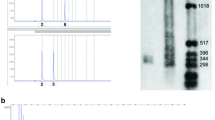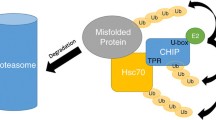Abstract
Huntington’s disease (HD) is an autosomal dominant disorder characterized by a triad of chorea, psychiatric disturbance and cognitive decline. Around 1% of patients with HD-like symptoms lack the causative HD expansion and are considered HD phenocopies. Genetic diseases that can present as HD phenocopies include HD-like syndromes such as HDL1, HDL2 and HDL4 (SCA17), some spinocerebellar ataxias (SCAs) and dentatorubral-pallidoluysian atrophy (DRPLA). In this study we screened a cohort of 21 Greek patients with HD phenocopy syndromes for mutations causing HDL2, SCA17, SCA1, SCA2, SCA3, SCA8, SCA12 and DRPLA. Fifteen patients (71%) had a positive family history. We identified one patient (4.8% of the total cohort) with an expansion of 81 combined CTA/CTG repeats at the SCA8 locus. This falls within what is believed to be the high-penetrance allele range. In addition to the classic HD triad, the patient had features of dystonia and oculomotor apraxia. There were no cases of HDL2, SCA17, SCA1, SCA2, SCA3, SCA12 or DRPLA. Given the controversy surrounding the SCA8 expansion, the present finding may be incidental. However, if pathogenic, it broadens the phenotype that may be associated with SCA8 expansions. The absence of any other mutations in our cohort is not surprising, given the low probability of reaching a genetic diagnosis in HD phenocopy patients.

Similar content being viewed by others
References
Ross CA, Tabrizi SJ (2011) Huntington’s disease: from molecular pathogenesis to clinical treatment. Lancet Neurol 10:83–98
The Huntington’s Disease Collaborative Research Group (1993) A novel gene containing a trinucleotide repeat that is expanded and unstable on Huntington’s disease chromosomes. Cell 72:971–983
Squitieri F, Berardelli A, Nargi E, Castellotti B, Mariotti C, Cannella M et al (2000) Atypical movement disorders in the early stages of Huntington’s disease: clinical and genetic analysis. Clin Genet 58:50–56
Kremer B, Goldberg P, Andrew SE, Theilmann J, Telenius H, Zeisler J et al (1994) A worldwide study of the Huntington’s disease mutation. The sensitivity and specificity of measuring CAG repeats. N Engl J Med 330:1401–1406
Wild EJ, Tabrizi SJ (2007) Huntington’s disease phenocopy syndromes. Curr Opin Neurol 20:681–687
Schneider SA, Walker RH, Bhatia KP (2007) The Huntington’s disease-like syndromes: what to consider in patients with a negative Huntington’s disease gene test. Nat Clin Pract Neurol 3:517–525
Stevanin G, Fujigasaki H, Lebre AS, Camuzat A, Jeannequin C, Dode C et al (2003) Huntington’s disease-like phenotype due to trinucleotide repeat expansions in the TBP and JPH3 genes. Brain 126:1599–1603
Keckarević M, Savić D, Svetel M, Kostić V, Vukosavić S, Romac S (2005) Yugoslav HD phenocopies analyzed on the presence of mutations in PrP, ferritin, and Jp-3 genes. Int J Neurosci 115:299–301
Costa Mdo C, Teixeira-Castro A, Constante M, Magalhães M, Magalhães P, Cerqueira J et al (2006) Exclusion of mutations in the PRNP, JPH3, TBP, ATN1, CREBBP, POU3F2 and FTL genes as a cause of disease in Portuguese patients with a Huntington-like phenotype. J Hum Genet 51:645–651
Wild EJ, Mudanohwo EE, Sweeney MG, Schneider SA, Beck J, Bhatia KP et al (2008) Huntington’s disease phenocopies are clinically and genetically heterogeneous. Mov Disord 23:716–720
Sułek-Piatkowska A, Krysa W, Zdzienicka E, Szirkowiec W, Hoffman-Zacharska D, Rajkiewicz M et al (2008) Searching for mutation in the JPH3, ATN1 and TBP genes in Polish patients suspected of Huntington’s disease and without mutation in the IT15 gene. Neurol Neurochir Pol 42:203–209
Rodrigues GR, Walker RH, Bader B, Danek A, Brice A, Cazeneuve C et al (2011) Clinical and genetic analysis of 29 Brazilian patients with Huntington’s disease-like phenotype. Arq Neuropsiquiatr 69:419–423
Panas M, Karadima G, Vassos E, Kalfakis N, Kladi A, Christodoulou K et al (2010) Huntington’s disease in Greece: the experience of 14 years. Clin Genet 80:586–590
Vincent JB, Yuan QP, Schalling M, Adolfsson R, Azevedo MH, Macedo A et al (2000) Long repeat tracts at SCA8 in major psychosis. Am J Med Genet 96:873–876
Juvonen V, Hietala M, Päivärinta M, Rantamäki M, Hakamies L, Kaakkola S et al (2000) Clinical and genetic findings in finnish ataxia patients with the spinocerebellar ataxia 8 repeat expansion. Ann Neurol 48:354–361
Gupta A, Jankovic J (2009) Spinocerebellar ataxia 8: variable phenotype and unique pathogenesis. Parkinsonism Relat Disord 15:621–626
Semaka A, Creighton S, Warby S, Hayden MR (2006) Predictive testing for Huntington disease: interpretation and significance of intermediate alleles. Clin Genet 70:283–294
Margolis RL, Holmes SE, Rosenblatt A, Gourley L, O’Hearn E, Ross CA et al (2004) Huntington’s Disease-like 2 (HDL2) in North America and Japan. Ann Neurol 56(5):670–674
Dobson-Stone C, Rampoldi L, Bader B, Baeza AV, Walker RH, Danek A et al (2002) Chorea-acanthocytosis. In: Pagon RA, Bird TD, Dolan CR, Stephens K (eds) GeneReviews [Internet]. Seattle 1993–1998 [updated 2011 Aug 18]. http://www.ncbi.nlm.nih.gov/books/NBK1387/ (Accessed 24 October 2011)
Ikeda Y, Daughters RS, Ranum LP (2008) Bidirectional expression of the SCA8 expansion mutation: one mutation, two genes. Cerebellum 7:150–158
Baba Y, Uitti RJ, Farrer MJ, Wszolek ZK (2005) Sporadic SCA8 mutation resembling corticobasal degeneration. Parkinsonism Relat Disord 11:147–150
Munhoz RP, Teive HA, Raskin S, Werneck LC (2009) CTA/CTG expansions at the SCA 8 locus in multiple system atrophy. Clin Neurol Neurosurg 111:208–210
Wu YR, Lin HY, Chen CM, Gwinn-Hardy K, Ro LS, Wang YC et al (2004) Genetic testing in spinocerebellar ataxia in Taiwan: expansions of trinucleotide repeats in SCA8 and SCA17 are associated with typical Parkinson’s disease. Clin Genet 65:209–214
Day JW, Schut LJ, Moseley ML, Durand AC, Ranum LPW (2000) Spinocerebellar ataxia type 8. Clinical features in a large family. Neurology 55:649–657
Ito H, Kawakami H, Wate R, Matsumoto S, Imai T, Hirano A et al (2006) Clinicopathologic investigation of a family with expanded SCA8 CTA/CTG repeats. Neurology 67:1479–1481
Ikeda Y, Dalton JC, Day JW, Ranum LP (2001) Spinocerebellar ataxia type 8. In: Pagon RA, Bird TD, Dolan CR, Stephens K (eds) GeneReviews [Internet]. Seattle 1993–1998 [updated 2007 Feb 7]. http://www.ncbi.nlm.nih.gov/books/NBK1268/#sca8 (Accessed 24 October 2011)
Worth PF, Houlden H, Giunti P, Davis MB, Wood NW (2000) Large, expanded repeats in SCA8 are not confined to patients with cerebellar ataxia. Nat Genet 24:214–215
Stevanin G, Herman A, Dürr A, Jodice C, Frontali M, Agid Y, Brice A (2000) Are (CTG)n expansions at the SCA8 locus rare polymorphisms? Nat Genet 24:213
Schöls L, Bauer I, Zühlke C, Schulte T, Kölmel C, Bürk K et al (2003) Do CTG expansions at the SCA8 locus cause ataxia? Ann Neurol 54:110–115
Ikeda Y, Dalton JC, Moseley ML, Gardner KL, Bird TD, Ashizawa T et al (2004) Spinocerebellar ataxia type 8: molecular genetic comparisons and haplotype analysis of 37 families with ataxia. Am J Hum Genet 75:3–16
Moseley ML, Zu T, Ikeda Y, Gao W, Mosemiller AK, Daughters RS et al (2006) Bidirectional expression of CUG and CAG expansion transcripts and intranuclear polyglutamine inclusions in spinocerebellar ataxia type 8. Nat Genet 38:758–769
Daughters RS, Tuttle DL, Gao W, Ikeda Y, Moseley ML, Ebner TJ et al. (2009) RNA gain-of-function in spinocerebellar ataxia type 8. PLoS Genet;5:e1000600. Epub 2009 Aug 14
Acknowledgments
The work of MGS, NWW and HH was undertaken at UCLH/UCL, which received a proportion of the funding from the Department of Health’s NIHR Biomedical Research Centres funding scheme. NWW and HH are grateful to the MRC and Wellcome Trust for funding.
Conflicts of interest
The authors report no conflict of interest.
Author information
Authors and Affiliations
Corresponding author
Rights and permissions
About this article
Cite this article
Koutsis, G., Karadima, G., Pandraud, A. et al. Genetic screening of Greek patients with Huntington's disease phenocopies identifies an SCA8 expansion. J Neurol 259, 1874–1878 (2012). https://doi.org/10.1007/s00415-012-6430-9
Received:
Revised:
Accepted:
Published:
Issue Date:
DOI: https://doi.org/10.1007/s00415-012-6430-9




